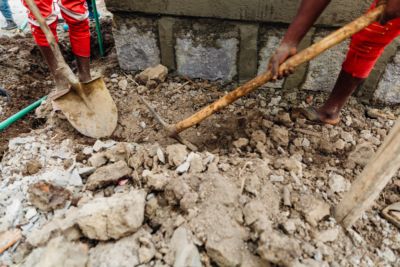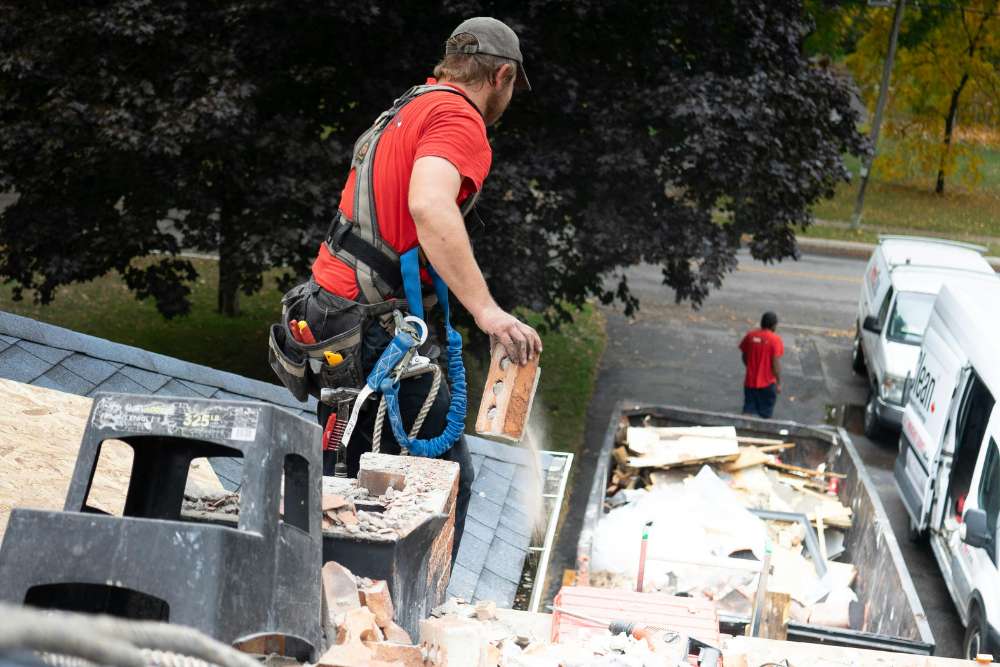
Playset Removal A Fun Project for Your Yard
September 9, 2025Tips for Efficient Kitchen Demolition Cleanup
September 9, 2025How to Safely Deal with Concrete Debris After Removal
Concrete removal often marks a major step in property upgrades, whether it’s tearing out an old patio, dismantling a cracked driveway, or preparing land for new construction. While the removal itself is a strenuous task, what many people underestimate is the amount of debris left behind. Heavy chunks, fine dust, and sharp fragments can quickly overwhelm a space if not addressed properly. Without a plan, cleanup becomes a safety hazard and a time-consuming challenge.
Properly handling concrete debris is about more than convenience—it’s about protecting people, the property, and the environment. A structured approach ensures that waste is cleared responsibly, valuable materials are repurposed when possible, and the site is left safe for future projects. With preparation and the right disposal strategies, dealing with concrete debris can shift from overwhelming to manageable, allowing your renovation goals to move forward without unnecessary setbacks.
Understanding the risks of leftover concrete debris
Concrete debris may appear harmless at first glance, but it carries hidden risks that can complicate any project. Heavy slabs pose tripping hazards, while jagged edges can easily cause cuts or punctures. Dust created during demolition lingers in the air, irritating the lungs and coating nearby surfaces. Without proper containment, it can spread to other parts of your property, leaving behind a stubborn mess that takes days to clean.
Beyond immediate safety concerns, concrete waste can also strain your property’s structure if piled incorrectly. Large chunks can damage landscaping, crack paving stones, or create uneven weight distribution. Recognizing these risks at the start helps you treat debris management as a crucial stage of the process rather than an afterthought. With a clear understanding of the hazards, you’ll approach cleanup with greater caution, ensuring the area remains safe and your renovation project progresses without added complications.
Sorting concrete debris into useful categories
Not all concrete debris should be treated the same. Breaking the waste into categories such as reusable blocks, recyclable materials, and unusable scraps provides clarity during cleanup. For instance, larger intact pieces might be saved for filling landscaping features, while smaller fragments can be directed toward recycling facilities that turn them into aggregate for new projects. Sorting helps maximize the potential of what might otherwise be discarded as waste.
This methodical approach also makes disposal easier. When debris is pre-separated, removal services or recycling centers can process it faster, sometimes even reducing costs. It prevents recyclable material from being unnecessarily sent to landfills and ensures resources are used to their fullest. Sorting may require extra time during cleanup, but the payoff is substantial. By taking a little more care at this stage, you transform debris from a problem into a set of possibilities for repurposing or recycling.

Choosing the right equipment for cleanup
Concrete debris is heavy and unforgiving, which makes proper equipment a necessity. Wheelbarrows, heavy-duty buckets, and sturdy shovels make transporting smaller pieces manageable, while dollies or lifting straps help with larger chunks. Gloves, dust masks, and safety goggles are also non-negotiable when working with this material, as concrete dust and sharp edges pose real risks.
In larger projects, renting a skid steer, mini excavator, or even a roll-off dumpster can make the job significantly more efficient. These tools prevent strain on your body and reduce the time it takes to move waste from the site. Having the correct equipment on hand before cleanup begins avoids delays and ensures safety is prioritized. With the right combination of tools and protective gear, managing heavy debris becomes a structured task rather than an exhausting and unsafe burden.
Recycling options for concrete waste
One of the most effective ways to handle concrete debris is recycling. Instead of heading to the landfill, concrete can be crushed into aggregate used in new construction, road base, or landscaping material. Recycling not only conserves landfill space but also supports sustainable building practices, reducing the demand for new raw materials. Many local facilities specialize in processing concrete and can provide affordable drop-off or pickup services.
Exploring recycling options also benefits your renovation budget. In some cases, recycling is less expensive than landfill disposal, especially when waste is sorted beforehand. By directing concrete to recycling centers, you contribute to a circular economy while making your project more eco-friendly. Recycling turns what seems like unwanted rubble into valuable resources, demonstrating that debris doesn’t have to signify waste—it can become the building blocks of future projects.
Exploring creative reuse ideas for leftover concrete
Concrete doesn’t always need to leave your property; in fact, it can be repurposed in ways that add character to outdoor spaces. Large slabs may be reshaped into stepping stones, retaining walls, or garden borders. Smaller chunks can serve as filler for pathways or drainage areas. Creative reuse reduces disposal costs while giving your landscape a unique and functional upgrade.
Repurposing materials also offers environmental benefits. Instead of consuming new resources for outdoor projects, you’re giving existing materials a second life. This approach aligns with sustainable practices and adds personal value to your home improvements. Thinking creatively about reuse shifts your perspective, turning debris into an opportunity for innovation. By reimagining the role of leftover concrete, you transform what might have been waste into functional and aesthetic elements that enhance your property long after the demolition ends.
Scheduling junk removal services for efficiency
For many homeowners, the sheer volume of concrete waste makes professional junk removal the most practical choice. Coordinating pickups at the right time prevents debris from accumulating into unmanageable piles. Instead of letting concrete clutter your yard or driveway, scheduled removals keep the site clean and ready for the next phase of work.
Junk removal services also handle the heavy lifting and transportation, which reduces physical strain and saves valuable time. Professionals understand how to load, sort, and dispose of concrete in compliance with local regulations. Their efficiency allows you to stay focused on your renovation without being bogged down by logistics. By scheduling services strategically, you streamline the entire cleanup process and prevent debris from becoming a long-term obstacle.
Maintaining safety during concrete cleanup
Concrete debris cleanup is physically demanding and comes with inherent risks. Heavy lifting can strain muscles or cause injuries if proper techniques aren’t followed. Wearing protective gloves and steel-toed boots guards against cuts and crushed toes, while masks help limit inhalation of fine dust particles. Safety precautions must remain central throughout the cleanup process.
Beyond personal protection, organizing the workspace adds another layer of safety. Keeping walkways clear, working in teams when moving large slabs, and avoiding overexertion all reduce the likelihood of accidents. It’s better to make several smaller trips than to risk injury with one overly heavy load. By maintaining safety as a top priority, cleanup progresses steadily without setbacks caused by preventable mishaps, ensuring everyone involved remains secure.
Protecting the surrounding property during cleanup
Concrete removal doesn’t just affect the targeted area; it can also impact landscaping, driveways, and nearby structures if not managed carefully. Heavy slabs dragged across lawns can leave ruts, while dust and small fragments can damage delicate surfaces. Laying down plywood or tarps in high-traffic areas creates a protective buffer for your property.
Attention to containment reduces the need for costly repairs later. Shielding flower beds, covering patios, and sealing windows keeps debris from spreading beyond the work zone. A little foresight ensures that while the old concrete is removed, the rest of your property remains intact. Protecting surrounding areas emphasizes that effective cleanup is about more than removing waste—it’s also about preserving the environment you’ve worked hard to maintain.
Preparing the site for the next stage of renovation
Once the concrete debris has been cleared, the focus shifts toward preparing the site for what comes next. This might involve grading the soil, compacting the ground, or laying a foundation for new materials. A debris-free site not only looks cleaner but also ensures structural stability for future projects.
Preparation at this stage sets the tone for everything that follows. Without leftover rubble in the way, contractors or homeowners can move forward with clarity and efficiency. Sweeping up dust, checking for overlooked fragments, and leveling the ground provides a solid foundation for improvements. The transformation truly begins once the site is cleared and ready, turning potential obstacles into opportunities for progress.
Adapting debris removal strategies to project size
The scope of your project should guide how you manage debris. Small DIY jobs might only require a truckload of waste removal, while larger demolitions demand multiple dumpsters and professional hauling. Tailoring your approach ensures efficiency and prevents overcommitting resources or underestimating the scale of the job.
Assessing project size also helps determine whether professional assistance is worth the investment. For smaller cleanups, handling debris yourself may be manageable. For larger undertakings, professionals provide the manpower, tools, and disposal options needed to keep everything on track. By adapting your strategy to fit the specific demands of your project, you strike the right balance between practicality and efficiency, ensuring the cleanup process runs smoothly regardless of scale.
Conclusion
Handling concrete debris after removal is not a task to take lightly. From dust control to debris disposal, each step requires planning to ensure safety, efficiency, and sustainability. By sorting materials, protecting your property, and considering recycling or reuse options, you minimize waste while maximizing potential benefits. Professional junk removal services add another layer of convenience, especially for larger projects that generate more waste than expected.
For homeowners in Santa Rosa, CA, North Bay Junk Removal provides reliable solutions for handling concrete debris and other cleanup needs. With their expertise in junk removal, they ensure heavy loads are managed safely and disposed of responsibly. Whether you’re renovating, rebuilding, or simply clearing space, their team is ready to make the process simpler. To schedule service or learn more about options, call 707-478-6817 and let North Bay Junk Removal help you complete your project with confidence.



